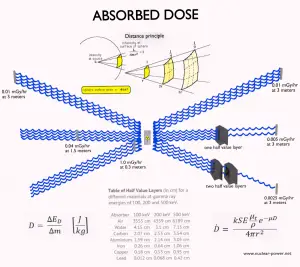Absorbed Dose
Absorbed dose is defined as the amount of energy deposited by ionizing radiation in a substance. Absorbed dose is given the symbol D. The absorbed dose is usually measured in a unit called the gray (Gy), which is derived from the SI system. The non-SI unit rad is sometimes also used, predominantly in the USA.
- Gray. A dose of one gray is equivalent to a unit of energy (joule) deposited in a kilogram of a substance.
- RAD. A dose of one rad is equivalent to the deposition of one hundred ergs of energy in one gram of any material.
A dose of one gray is equivalent to a unit of energy (joule) deposited in a kilogram of a substance. This unit was named in honour of Louis Harold Gray, who was one of the great pioneers in radiation biology. One gray is a large amount of absorbed dose. A person who has absorbed a whole body dose of 1 Gy has absorbed one joule of energy in each kg of body tissue.
Kerma
Kerma is a measure of kinetic energy transferred from radiation to matter. It is an acronym for “kinetic energy released per unit mass”. Kerma is given the symbol K and it is measured by the SI unit, the gray. This unit was named in honour of Louis Harold Gray, who was one of the great pioneers in radiation biology. Kerma is defined by the formula:
Kerma vs Absorbed Dose
Kerma is related to, but not the same as absorbed dose. Absorbed dose is defined as the amount of energy deposited by ionizing radiation in a substance. Kerma is defined as the sum of the initial kinetic energies of all the charged particles liberated by uncharged ionizing radiation in a substance. At low energies, kerma approximately equals absorbed dose, since most of initial kinetic energies of all the charged particles deposit their energy in the sample. At higher energies kerma is larger than absorbed dose because some highly energetic secondary electrons and X-rays escape the region of interest before depositing their energy. The escaping energy is counted in kerma, but not in absorbed dose. Note that there are three key interaction mechanisms of gamma rays with matter.
We hope, this article, Kerma vs Absorbed Dose, helps you. If so, give us a like in the sidebar. Main purpose of this website is to help the public to learn some interesting and important information about radiation and dosimeters.


